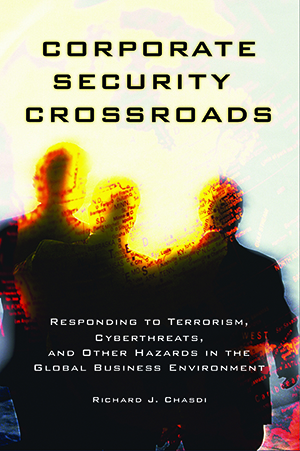Book advises corporations on how to respond to terrorism, cyberthreats and other hazards
Corporate Security Crossroads: Responding to Terrorism, Cyberthreats, And Other Hazards In The Global Business Environment, by Richard J Chasdi, explores the root causes of the different sectors of terrorism and how businesses can develop strategies to defend against these threats.
 Whether a high-profile target for organised terrorist groups, cyber terrorists, and lone wolf terrorists, or the target for non-politicised violence, such as the recent shooting at YouTube headquarters, domestic and international corporations are at a security crossroads, says Richard J Chasdi, PhD in this book.
Whether a high-profile target for organised terrorist groups, cyber terrorists, and lone wolf terrorists, or the target for non-politicised violence, such as the recent shooting at YouTube headquarters, domestic and international corporations are at a security crossroads, says Richard J Chasdi, PhD in this book.
In creating a counterterrorism strategy, it’s crucial to distinguish between threats based on advancing the political agendas of terrorist groups, and those undertaken primarily with non-political motives, such as industrial espionage, cybercrime, and workplace sabotage. “It’s essential to understand the different forms of threats to international business and what can be done to constrain and control those threats,” says Chasdi. “This involves recognising both the political grievance and non-political greed dimensions of threat.”
Threat types can be categorised along a continuum that reflects different mixtures of non-political and political factors. At one end of the continuum lie common criminal activities motivated by pure greed. At the other end lie terrorism and cyberterrorism, motivated primarily by political grievance at local or global levels. In the middle lies industrial espionage, reflecting a mix of greed and political motivations.
Threats can be analysed at three levels:
The international political system level
The nation-state level
The individual/small group level
This three-level analysis provides a framework to assess basic threats and all three levels need to be taken into account for a complete and accurate analysis of the likelihood that threats can occur.
Chasdi recommends that corporations employ both traditional security measures and soft techniques aimed at eliminating the root causes of terrorism in the geographies where they are located, such as worker compensation packages, dispute resolution mechanisms, and employee healthcare, all of which help offset perceptions that international enterprises only care about profit at the expense of worker health and well-being.
“Cookie-cutter strategies to confront terrorism are a recipe for failure,” he says. “Each operational environment where a multinational corporation is located is characterised by political, historical, and cultural factors that require individualized attention.”
Corporate Security Crossroads introduces the Total Security Measure Index (TSM) that makes it possible to compare traditional defensive protections in place at the time of an attack with augmented hard and soft defensive measures that could have improved the defensive posture of the target.
Chasdi recommends that businesses compile a portfolio of past incidents in various environments where firms operate based on terrorist group type, geographical/topography characteristics, resource endowments, and time interval to provide appraisals of terrorist group activities in international enterprise locales. Once such a portfolio of cases is produced, it should be possible to determine areas of security vulnerability based on regular and discernable patterns that appear.
Chasdi also highlights lone wolf terrorists and the threats they pose to international business, including an in-depth empirical study of lone wolf terrorist characteristics. Those include relationships between:
-
Terrorist lone wolf type and age
-
Terrorist lone wolf type and business settings where terrorist actions are conducted
-
Terrorist lone wolf type and target type
-
Lone wolf ideology and target silhouette
-
Terrorist lone wolf type and immigrant or second-generation status
-
Terrorist lone wolf type and paramilitary or military instruction
-
Lone wolf type and region of operation
-
Assault type and world region
-
Lone wolf type and previous group ties
Filled with detailed analyses, case studies drawn from terrorist events around the world, and insightful viewpoints, Corporate Security Crossroads aims to help corporations to combat terrorist threats by understanding the complex political, social, and economic environments in which they operate.
Richard J. Chasdi, PhD, is professor of management and associate director of the Center for Complex and Strategic Decisions at Walsh College. He serves on the editorial board of Armed Forces & Society and Perspectives on Terrorism: A Journal of the Terrorism Research Initiative. He has also served as a member of the international advisory board of Terrorism: An Electronic Journal (TEJ). Chasdi is the author of three other books as well as articles and book chapters. In addition, he was a Fulbright Specialist at the Nanyang Technological University, Singapore, where he was a Visiting Fellow at the International Centre for Political Violence and Terrorism Research (ICPVTR). He received his master’s degree from Boston College and his doctorate in political science from Purdue University.
Corporate Security Crossroads: Responding to Terrorism, Cyberthreats, And Other Hazards In The Global Business Environment, by Richard J. Chasdi, is published by Praeger; ISBN: 978-144083285